Important Persons

Chief Minister
Shri. Pramod Sawant

Hon'ble Minister of Archives
Shri. Subhash Phaldesai

Director of Archives
Shri. Arvind Khutkar
Historical Background

















































